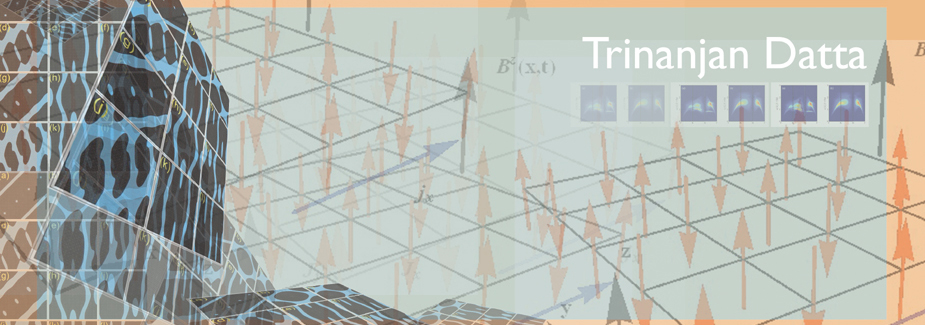
Home
Teaching
Research
Publications
Presentations
Research Group
News & Publicity
Seminar & Links
Fall 2024
PHYS 3250 - Theoretical Mechanics
In this course you will be introduced to the concepts of theoretical mechanics (also referred to as classical mechanics). The course will deal with the description and explanation of the motion of objects. The part of the course that deals only with the geometrical description of motion, such as Galileo's laws of falling bodies, is called kinematics. The part that offers a causal explanation of the motion along with its description is called dynamics, such as application of Newton's laws of motion. Besides studying the elementary concepts of mechanics at a more sophisticated mathematical level in this course, we will also study formalisms (Lagrangians and Hamiltonians) that allow us to make a conceptual transition to quantum mechanics from classical physics. Two of the most important skills that you will learn from this class is the ability to apply advanced mathematical concecpts to describe physical phenomena and to interpret those mathematical results in physical terms. You will also learn how to use and apply the computer algebra system Mathematica to perform symbolic and numerical computation as appropriate for an undergraduate theoretical mechanics course.
PHYS 1111L - Introductory physics I (lab course)
This course is designed to guide your learning of fundamental concepts of experimentation, data collection and data analysis in the physics laboratory using Arduino. These lessons will be delivered through hands-on experiments typically dealing with how and why objects with mass move and interact with other objects. And although the typical student in PHYS 1111L may not intend to become a practicing physicist, everyone can share an appreciation of the scientific process. The hope is that you will walk away at the end of the course having developed an appreciation not only for some of the techniques you have learned, but also what it means for a scientist to claim they “know” something based on experimentation.
Physics is an experimental science, and this course (PHYS 1111L) is designed to introduce laboratory techniques which will be focused on experiments dealing with forces, masses, and motion. The process of using a set of tools to acquire physical data and then analyzing that data to reach conclusions is fundamental to most subject areas and courses that you may take later.
However, the primary purpose of PHYS 1111L is NOT to duplicate concepts discussed in the lecture portion (PHYS 1111) of the course. While reinforcement is beneficial and intended, the lab course is independent of the lecture and will cover additional independent concepts. The topics covered during the lecture serve as examples that we can explore in lab to learn how to trust and believe in those physical principles. The schedule of material in each lecture may not correspond directly with the material in lab which, as has been said, will focus on observing and measuring physical phenomena. The courses complement one another but will seldom track each other.
Computational Teaching Resources
Computation (use of a computer to numerically solve, simulate, and visualize a physical problem) has revolutionized scientific research and engineering practice. However, STEM (physics, chemistry, mathematics, computer science, and engineering) majors enrolled in introductory physics are not adequately exposed to computational modeling and analysis. Students enrolled in a traditional introductory calculus based physics course (still widely implemented across the nation) have minimal or zero exposure to computational physics tools and ideas. Solving computational problems in physics is not just about physics knowledge but also about skills and knowledge associated with math, programming, and modeling. To meet this growing need I utilize Visual Python (VPython) in my introductory calculus based physics course to promote a problem-solving environment where students can numerically solve physics problems, create visual simulations, practice mathematical and physical modeling, and investigate physics phenomena, rather than just calculating an answer. VPython is an open-source, freely available environment accessible to users of all major computing platforms. Such an approach has already been pioneered by Chabay and Sherwood in their Matter & Interactions (M&I) curriculum, which introduces computational modeling as an integral part of the introductory physics course. For purposes of visualizing 2D scientific data we utilize Matplotlib.
Useful Links:
Visual Python
Matplotlib
Other courses taught:
Physical science – physics for non science majors (PHSC1011), Algebra based physics (PHYS1111 & 1112), Honors physics, Calculus based physics (PHYS2211 & 2212), Thermal physics (PHYS4310), Theoretical Mechanics (PHYS3250), Quantum Mechanics (PHYS 4600, online), and Special Topics courses (PHYS 4950 – Advanced Statistical Mechanics, Solid State Physics, and Magnetic materials, Numerical Computing using Fortran 90, and Many Particle Physics)
 |